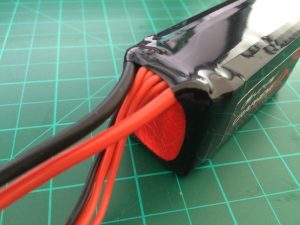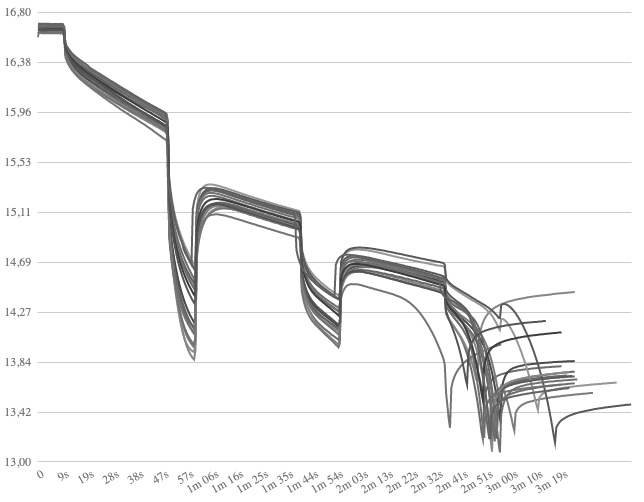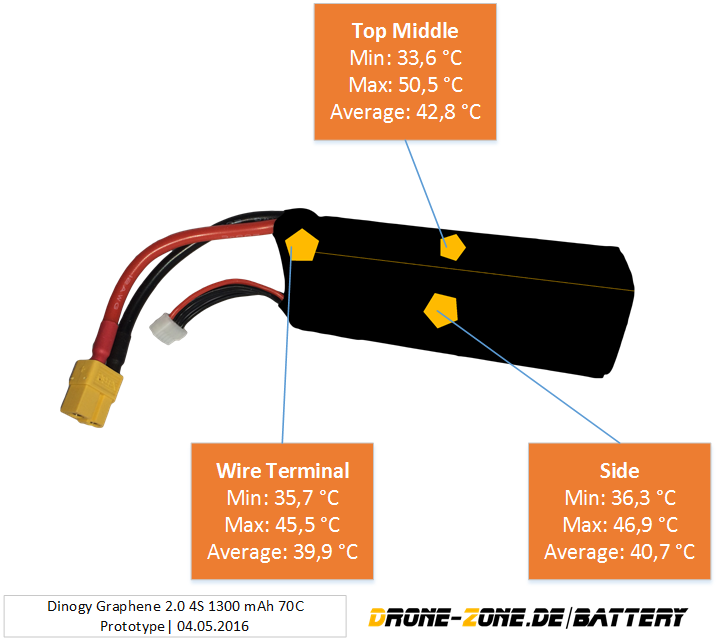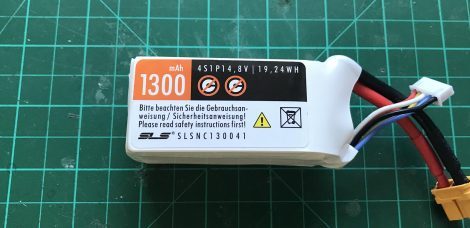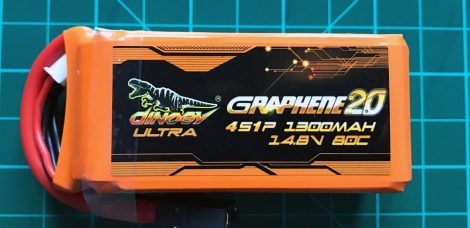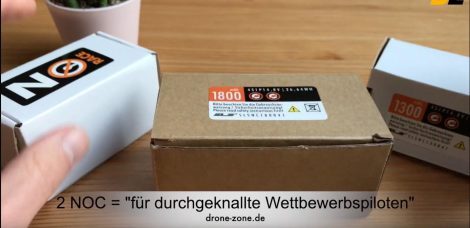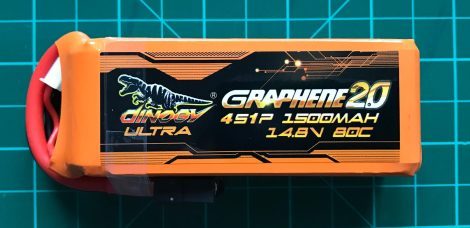I am proud to present you a first review of the all new Dinogy Graphene 2.0 batteries, that have been developed in dedication to all of us FPV racers. The new graphene generations is supposed to have less voltage sag on hard punsh-outs. This articles looks at the Dinogy Graphene 2.0 1300 mAh 70C pack prototype.
Appearance
As the graphene chemistry utilizes carbon nano particles to improve performance, the prototype Dinogy Graphene 2.0 pack is colored black. The front and back are made out of some red, honeycombs-looking, textural material that’s reflecting light in a cool way. Might even come in handy when you have lost your quad in grass on a sunny day! On the sides you find two stickers. One with the product name printed on, the other one holds all the important information like cut-off voltages, charge rates, storage voltages, etc. That’s something by the way, a lot more lipo brands should do: Just put the important stuff right on the pack and not in some manual that’s never with you on the field. The final product will be colored grey and have black XT60 connectors:
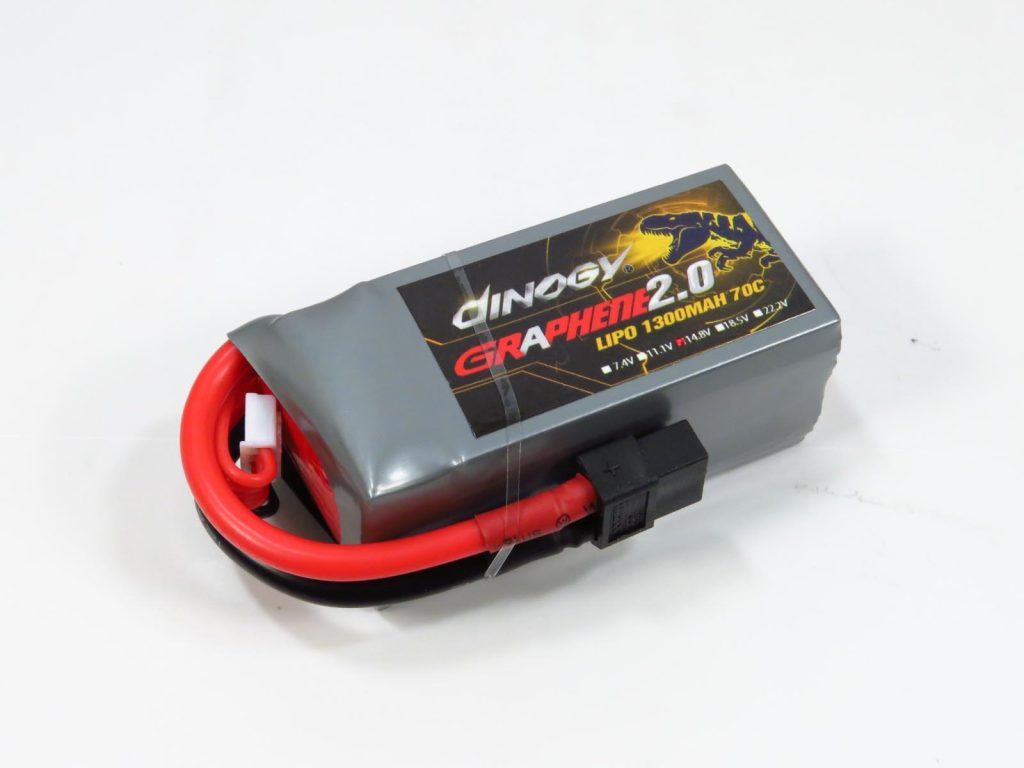 Bildquelle: L&E Battery Industrial | ©
Bildquelle: L&E Battery Industrial | ©Technical Design
The Dinogy Graphene 2.0 70C pack is a standard 4S1P config flight pack for high power use. It utilizes the new generation graphene cell chemistry. An extra layer of carbon particles is added to minimize internal resistance. That’s at least the theory, we will see how this new technology behaves in real-world conditions.
Build Quality: Very good. Pack feels very well made on the outside. Connection terminal looks solid. Shrink wrapping job is good.
Plugs: The Dinogy Graphene 2.0 batteries come with pre-installed XT60 connectors*. Plug and play for most of the pilots. The ones on the prototype are yellow, the final product will have black ones.
Cables: Dinogy uses 14 AWG wires on this packs. The high flexible silicon layer is rated up to 200°C. Cable length is about 10 centimeters.
Balacing plugs: Standard XT-system*. Balance wires are rather long (6 cm) which is a benefit in terms of easy handling while charging. On the other hand you have to make sure that you get it out of the way of your props. Main power line and balancer wires are coming out of the top of the pack. Balancing plugs on final product will be shorter (see picture above).
Technical Details
Break-in documentation
The battery followed the standard break-in-process: The pack is charged at a rate of 1C until CV-phase ends with current of 1/10C. The break-in phase consists of four charging cycles at 1C and four corresponding discharges at 1 C / 4C / 10C and 20 C.
Anomalies: No anomalies during break-in.
Internal resistance measurements during break-in phase via iCharger 406B at 40°C pack temperature
| Cycle | Cell 1 | Cell 2 | Cell 3 | Cell 4 | Total | Connection |
| After first charge | 2.8 | 2.3 | 2.6 | 2.4 | 10.1 | 21.1 |
| After second charge | 2.1 | 2.3 | 1.9 | 2.3 | 8.6 | 21.9 |
| After third charge | 2.0 | 2.1 | 1.9 | 2.0 | 8.0 | 17.0 |
| After fourth charge | 2.4 | 2.5 | 1.6 | 2.4 | 8.9 | 18.9 |
Charging process
CV-Phase is really short on this cell type. Balacing in normal mode took 1:50 min. Cell drift during charge was unobtrusive. This is for 1C charge (1,3 A).
Load Testing
The main part of this battery test will consists of different load test settings showing the battery performance. Constant load testing is used to judge the advertised C-ratings as well as look at cell drift under high loads. We also check on internal resistance once more. Next up is the dynamic current test, which simulates a „real“ flight with changing (=dynamic) loads. For test methodology please check the dedicated methodology page!
Constant Load Testing
Constant load testing follows a certain load pattern of different constant currents. Base load is 10 C. Current pulses at 50 C, 35 C, 20 C and 30 C are maintained for time intervals between 10 and 20 seconds. For more details please refer to the test methodology page.
Capacity Usage
During this test the pack delivered 952 mAh. This is 73,2 % of nominal capacity. A solid value.
Average cell voltages
The following table lists the average voltages per cell, of the total pack, as well as the averaged value per cell as fraction of total voltage during phase of active load.
| Cell 1 | Cell 2 | Cell 3 | Cell 4 | Total | Average per cell | |
| Avg. Voltages | 3,743 | 3,738 | 3,745 | 3.743 | 14,969 | 3.742 |
Just looking at average values the Dynogy pack performs well. All cells stayed above 3.71 V on average. An average value above 3.70 V / cell can be considered very good in this capacity class.
Focus Voltages
Exceptionally interesting when testing a battery under a constant load for a longer period of time: the lowest voltage per cell just before load impulse is disabled. On top, you should have look at voltage recovery rate, that is: how fast do cell voltages rise again once load impulse is cut.
| Phase | Cell 1 | Cell 2 | Cell 3 | Cell 4 | Total |
| End of 50 C | 3.529 | 3.525 | 3.549 | 3.547 | 14.176 |
| End of 35 C | 3.532 | 3.524 | 3.542 | 3.558 | 14.156 |
| End of 20 C | 3.285 | 3.254 | 3.324 | 3.334 | 13,197 |
| End of 30 C | – | – | – | – | – |
The average cell voltage stability on the Dinogy pack can be considered very good. No cell ever fell below 3.5 V during the first two current pulses.
Average voltage recovery per second
Those values are specific to the test setting and not valid for the pack in general! Still they allow an estimated guess about how fast voltages rise again after current spikes.
| Cell 1 | Cell 2 | Cell 3 | Cell 4 | Total | |
| Avg. Recovery [V/s] | 0.039 | 0.0389 | 0.0362 | 0.0313 | 0.1455 |
Excessive voltage sag isn’t a problem for this battery. Recovery rates after current pulses are decent, too.
IR-Measurement
IR measurement is conducted using the four current pulses. Resistance for each cell is calculated in all four discharge phases. Shown values are averaged to cancel out different temperature points due to different discharge states during measurements.
| Cell | 1 | 2 | 3 | 4 | Total |
| Resistance [mΩ] | 3.29 | 3.19 | 2.82 | 2.31 | 11.57 |
Interpretation: The internal resistance of 2.9 mΩ average per cell indicates a „true“ C-rating of around 40 C (52.0 A). A very good valued. This calculation is on the conservative side and represents a current draw that will make the pack last for a long time. See load testing for further categorization. The pack had no problems delivering during high C discharge pulses. Voltage stayed well above 3.5 V on this test for 50 C, 35 C and 20 C loads. Note: Cell #3 & 4 are cleary the strongest of all four. As this is a protype pack, having cell #4’s performance in the final product for all cells would be awesome (resulting in a close to real 50C pack!)
Cell drift under load
| Discharge Phase | 50 C | 35 C | 20 C | 30 C |
| Max Cell drift (V) | 0.012 V | 0.034 | 0.062 | – |
The Dinogy Graphene 2.0 prototype has a really low drift during main discharge phase. To the very end of the cycle cells drift strong. Performance wise that’s not a problem as it happens within the last seconds before cut-off. A fraction of the drift is caused by the single strong cell, holding up voltage longer than the other three cells: e.g. total drift increases.
Key Temperature Facts
Temperature Development
All temperature probes reported values below cut-off point at 58°C. Max. temp during discharge was around 50.5 °C on top of pack. Note that heating of stressed LiPo packs will continue for some more time even when load is cut.
Market Comparison
The following chart shows all reviewed LiPos in the same product segment for direct comparison of performance. Higher values under load are better.
Constant 25 C Discharge
Pretty much a standard benchmark in the LiPo industry.
Cut-Off /warning value for this battery should be chosen 3.4 to 3.5 V minimum. After this point voltage drops very quick. The cut-off recommendation of 3.4 V therefore might be a little optimistic. At least cut-off in this case means cut-off! No slow landing or „just another round around that tree“. Otherwise you will hit the critical 3,0 V barrier before you landed. Go with 3.5 V/cell. Better safe than sorry. The battery provided 957 mAh (73,6 %) during the 25 C discharge. A very solid value!
Market Overview
Comparison of different reviewed 1300 mAh batteries under 25 C load.
Dynamic Load Testing
The dynamic load testing setting consists of two separate discharge scenarios that have been developed of two different real-life FPV flights. Pattern one represents a high speed low proximity flight around the open field with some hovering to the end. Average load is around 22 A. Second pattern is a free-style flight around trees in the park with some current spikes near 70 A. Average load on this flight is around 13 A due to longer floating periods.
Capacity Usage
During the test of pattern 1 the pack delivered 948 mAh. This is 72.9 % of nominal capacity. A good value. In patter 2 testing 951 mAh (73.1 %) could be used until first cell reached cut-off voltage.
Market Comparison
The following charts give an overview of all tested packs in the 1800 mAh class so far.
The last chart of this review sums up the usable capacity during all four load scenarios. Please note that this is only the capacity consumed by the electronic load! There are losses due to heating of the pack, which could be approximated (see testing methodology page). All four tests are cut when any cell goes below cut-off voltage of 3,3 V (or pack goes above 58 °C on any of the three probes). If you would push further and go down to 3,0 V/cell you will be able to squeeze out some mAh more, but at the cost of excessive heat generation and shortening of pack life-span. This value will most likely differ from what you get when flying on a quad as most people don’t monitor voltage on a per cell basis and therefore don’t even notice if voltage drops below 3,3 V/cell during punsh-outs (what’s not necessarily a good thing, though). For comparison, used capacity until 3,3 V/cell is reached is the base line in all battery reviews on Drone-Zone.de.
Conclusion
The Dinogy Graphene 2.0 4S 1300 mAh 70C battery is a usual sized pack with a average capacity to weight ratio of 8.44 mAh/g. Graphene enabled packs tend to be a little bit heavier than usual chemistry batteries. The measurements are standard for the 1300 mAh class.
The outer appearance of the prototype as well as the final product is well designed. I like the reflecting red surfaces. Cable selection is standard for main power line. Overall build quality is very good. The prototype Dinogy Graphene 2.0 feels very well made. Balancing phase on this pack type is really short (even at 1C charge). Internal resistance measurement shows a solid „real 40 C rating„. This is a very good result. I would not hesitate to use the pack in 40 – 45C constant (!) current draw applications.
Temperature development is fine. The pack never broke the 55 °C barrier. Voltage stability is another plus on the Dinogy Graphene 2.0 prototype. Cells stay above 3.7 V on average even under highest loads. Cell drift during main load phase (where the most energy is used) is almost perfectly tiny. The prototype showed two cells performing a little better than the rest. Expecting a slight performance increase and a little better cell selection in the final product with resistances between 2.0 and 2.5 mOhm on all four cells the Dinogy Graphene 2.0 4S 1300 mAh 70C is a great choice for 180 to 250 size quads with high power setups.
The price tag on this battery is expected to be somewhere around 30 US-$. That’s my assumption, dependent on the margin your retailer takes. For this prices you are getting a great battery, no doubts! Especially if you have a setup pulling high amps peak this pack will be pure fun!




